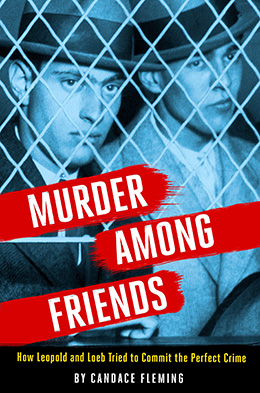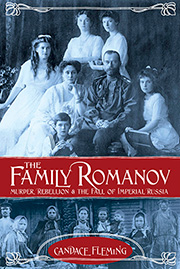BOOKS

Anne Schwartz Books,
Random House, March 2022
978–0593177426
ages 12 and up
buy the book
hardcover
e‑book
After you’ve read Murder Among Friends, try this book:
Murder Among Friends
How Leopold and Loeb Tried to Commit the Perfect Crime
How did two teenagers brutally murder an innocent child … and why? And how did their brilliant lawyer save them from the death penalty in 1920s Chicago? This is a compulsively readable true-crime story based on an event dubbed the “crime of the century.”
In 1924, eighteen-year-old college students Nathan Leopold and Richard Loeb made a decision: they would commit the perfect crime by kidnapping and murdering a child they both knew. But they made one crucial error: as they were disposing of the body of young Bobby Franks, whom they had bludgeoned to death, Nathan’s eyeglasses fell from his jacket pocket.
Author Candace Fleming depicts every twist and turn of this harrowing case — how two wealthy, brilliant young men planned and committed what became known as the crime of the century, how they were caught, why they confessed, and how the renowned criminal defense attorney Clarence Darrow enabled them to avoid the death penalty.
Reviews
“On May 21, 1924, 19-year-old Nathan Leopold and 18-year-old Richard Loeb drove through the streets of Kenwood, an affluent, partially Jewish neighborhood on Chicago’s South Side, looking for a random child to kill. They considered one of Richard’s little brother’s friends, but when that boy ran off, they settled on 14-year-old Bobby Franks, one of Richard’s cousins, with whom he’d played tennis the day before. Richard wished to prove himself a ‘master criminal’; Nathan wanted Richard to remain his lover. But despite general incompetence and corruption of Chicago’s police force at that time, the pair were quickly taken into custody and confessed. Though their guilt was unquestionable, their families sought no less an attorney than Clarence Darrow (eminent in his profession though not yet of Scopes Monkey Trial fame), who took the case due to his hatred of the death penalty. Insanity had until then been seen as a binary condition; Darrow, saying “all life is worth saving,” argued that it was a continuum that could mitigate without fully denying culpability. Fleming, a master of meticulously researched nonfiction, covers Leopold’s and Loeb’s troubled childhoods, the horrible crime itself, the odd bond between the newspapers and the police that facilitated a conviction, and Darrow’s intelligence and humanity. In the end, however, Leopold and Loeb are so chilling that readers won’t celebrate their judicial victory. Erudite, readable, and appalling.” (Kirkus Reviews, starred review)
“‘Nineteen-year-old Nathan Leopold would kill a child today.’ The kidnapping, ransom, and murder plot had been in the works for months, but it came to fruition on May 21, 1924, when Leopold and his friend, eighteen-year-old Richard Loeb, targeted Loeb’s second cousin, fourteen-year-old Bobby Franks, as he walked through their affluent Chicago neighborhood. Leopold and Loeb had privileged childhoods but ones with elements of neglect and abuse, potential red flags for their troubled relationship, in which Loeb got a partner in crime for his psychopathic tendencies and Leopold got a sexual relationship in exchange for enabling his partner’s criminal activity. While they pulled off the kidnapping and murder, the ransom plot fell apart, in part because Bobby’s body was found too quickly. The horrific crime puzzled the police, but the press, which pandered to the public’s insatiable appetite for scandal, helped solve the case. The ensuing trial saw Clarence Darrow trying to avoid the death penalty for the amoral, remorseless pair. There is a mountain of primary-source material for this story, and the narrative expertly parses it, giving readers an uncommon depth of psychological insight. This is, at once, a psychological crime thriller, a suspenseful courtroom drama, and a timely, relevant examination of social issues. In the field of YA narrative nonfiction, Fleming continues to outdo herself.” (Jonathan Hunt, The Horn Book, starred review)
“Acclaimed nonfiction author Fleming brings her usual lucid writing and meticulous research to this account of the lives and notorious crimes of Nathan Leopold and Richard Loeb, as well as the groundbreaking legal defense mounted by Clarence Darrow that saved them from execution. In a propulsive narrative, Fleming begins with the immediate lead-up to the murder they so carefully plotted before digging back into their troubled childhoods, intense friendship, and increasingly violent crimes. She wisely steers clear of sensationalizing the actual murder of Bobby Franks, relying instead on quotes from Leopold and Loeb’s own testimonies to describe the event and routinely reminding readers of the emotional fallout of Franks’ death on his family and community. The second half of the book focuses primarily on the police investigation and how Darrow built his case, particularly his impassioned belief in the immorality of capital punishment — an argument that ultimately convinced the judge to give each defendant a life sentence. Thoughtful asides about some of the common discriminatory attitudes at the time (homophobia, antisemitism, etc.) offer helpful context. The engrossing true-crime narrative style and high-interest subject will likely make this a very popular pick among teen readers, while the comprehensive look at Darrow’s defense strategy gives it lots of heft. Thought-provoking reading sure to spark further conversations about crime and punishment.” (Sarah Hunter, Booklist, starred review)
“In five distinct sections, this gripping, thriller-paced true crime portrait by Fleming centers Nathan Leopold (1904–1971) and Richard Loeb (1905–1936), who in May 1924 as University of Chicago students and on-again, off-again lovers targeted and killed Loeb’s 14-year-old second cousin Bobby Franks, in an attempt to commit the “perfect crime.” Beginning with a grisly account of the killing, the page-turning narrative next traces wealthy Leopold and Loeb’s childhoods and early friendship among Chicago’s Jewish elite, the tracking of the killers, the duo’s storied confessions, and the riveting courtroom battle involving attorney Clarence Darrow. Electrifying descriptions of the pivotal trial provide nuanced ethical and legal context around Darrow’s arguments against the death penalty. Fleming employs her usual flair for enlivening history, offering rich layers of information about the time, including the role that anti-Semitism, newspapers, and police corruption played in the case. Though Leopold and Loeb’s crime is difficult to stomach, Fleming crafts an absorbing saga sure to ensnare readers in its thrall. Black-and-white photographs and newspaper reproductions appear throughout, and an afterword and copious back matter reveal the book’s wealth of research.” (Publishers Weekly, starred review)


